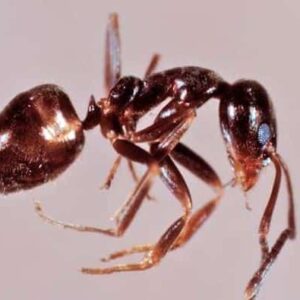
Argentine ant

The Argentine Ant’s Habitat
Argentine ants, known scientifically as Linepithema humile, thrive in diverse habitats, but their presence is particularly pronounced in urban landscapes. These tiny intruders establish nests in soil, under debris, and even within the walls of homes, creating expansive colonies that pose challenges for homeowners.
Transitioning seamlessly between urban and natural spaces, Argentine ants showcase their adaptability. They form nests in gardens, lawns, and even beneath potted plants. Their ability to exploit diverse environments contributes to their reputation as invasive pests.
Argentine Ant’s Diet and Anatomy
Argentine ants boast a fascinating reproductive system. Unlike some ant species, they engage in a process called “budding,” where colonies split into smaller units, each with a queen. This efficient reproductive strategy allows for the rapid expansion of their populations.
Argentine ants are not picky eaters. Their diet includes sweets, fruits, seeds, and even other small insects. Their keen sense of smell guides them to food sources, creating persistent trails that homeowners often encounter in kitchens and pantries.
Measuring between 1.6 to 2.8 millimeters, Argentine ants are relatively small. Their bodies are uniformly brown, lacking the distinct color variations seen in some other ant species. This unassuming appearance belies their potent impact on environments they invade.
The life cycle of Argentine ants consists of four stages: egg, larva, pupa, and adult. Colonies maintain a constant cycle, with queens laying eggs and workers tending to the developing brood. Understanding these stages is crucial for effective pest control interventions.
Environmental Impact
The ecological consequences of Argentine ant invasions are substantial. Their aggressive behavior often leads to the displacement of native ant species, upsetting the delicate balance of local ecosystems. Understanding these effects is crucial for developing sustainable pest control strategies.
Dealing with Argentine ant infestations requires a multifaceted approach. From identifying their nests to disrupting foraging trails, homeowners can implement practical measures. Regular cleaning, sealing entry points, and using ant baits are effective steps to deter these persistent invaders.
Seeking Professional Pest Control
When faced with persistent Argentine ant problems, seeking professional help is a wise decision. Pest control experts, armed with knowledge and effective interventions, can address infestations comprehensively. Passive voice is occasionally employed by pest control professionals when describing the process of tackling ant invasions.
Conclusion
In concluding the exploration of Argentine ants, it becomes clear that these tiny creatures wield significant influence in both urban and natural settings. By unraveling their habits, anatomy, and impact on ecosystems, homeowners can make informed decisions to mitigate the challenges posed by Argentine ant invasions. The key lies in coexistence strategies that balance effective pest control with an understanding of the role these microscopic invaders play in the intricate tapestry of our environments.

